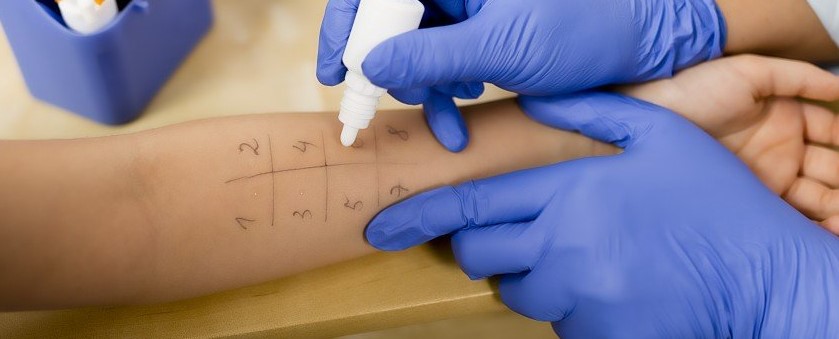Skin Prick Testing
Skin Prick Testing
Breathe Well offers skin prick testing, focussing on inhalational allergens. Skin Prick Testing is used to determine if an individual has an IgE-mediated hypersensitivity. This testing method can be a useful tool to screen for hypersensitivities driven by a broad array of common allergens, and a quick, cost-effective, and safe avenue towards a better understanding and management of chronic issues related to these hypersensitivities.

Indications for Skin Prick Testing include1:
- Asthma
- Eczema (atopic dermatitis)
- Chronic urticaria, if an IgE-mediated hypersensitivity is suspected
- Allergic conjunctivitis
- Rhinitis/rhinosinusitis/rhinoconjunctivitis
- Rarer disorders such as allergic bronchopulmonary aspergillosis.
Allergens tested:
- Acacia
- Bahai grass
- Bermuda grass
- Johnson Grass
- Ragweed Mix
- Plantain -English
- Grass Mix – Kentucky blue, Meadow fescue, Orchard, Perennial, Ryegrass, Retop/bent, Sweet vernal, Timothy
- Cat/ Dog Hair
- Feather Mix
- Cockroach Mix
- Guinea Pig
- European house dust mite
- Mould Mix – Alternata alternata, Aspergillus niger, Bipolaris sorokiniana, Sphaerosperumum, Penicillium chrysogenum var.
- Aspergillus fumigatus
- Cow’s milk
- Egg white
Frequently Asked Questions for Referring Doctors
Is Skin Prick Testing the best allergen test for my patient?
Skin Prick Testing is an appropriate first-line test for common IgE-mediated hypersensitivities2. Skin Prick Testing is more sensitive than Radioallergosorbent Testing (RAST)3, and more sensitive and more specific than Serum-Specific IgE Testing1. Our trained staff vigilantly screen for false-positives and false-negatives to deliver highly reliable testing for a broad battery of common allergens. In addition, it provides an excellent cost-effective allergen testing option, with rapid results – in as little as 20 minutes. Importantly, the patient’s ability to see real-time hypersensitivity reactions can be highly compelling, and a useful driver to compliance with allergen-avoidance. RAST testing is the test of choice for anyone in whom Skin Prick Testing is contraindicated (see below.)
How is the test performed?
Skin prick tests are usually performed on the inner forearm. The arm is cleaned with soap and water, or alcohol. The forearm is marked with a pen corresponding to the number of allergens. A drop of allergens is placed beside each mark. A lancet is used to make a small skin prick through the allergen. Readings are taken within 20 minutes.
Is Skin Prick Testing Safe?
Skin Prick testing is a very safe procedure, and causes minimal discomfort. Adverse reactions can occur but they are rare. The more common reactions are itchiness, and delayed local skin swelling, which is self-limiting. In very rare cases, people can experience vasovagal syncope, or have a systemic anaphylactic reaction. For this reason, Skin Prick Testing is performed with a respiratory specialist on site, and appropriate emergency equipment and medications to address significant reactions.
Are there any contraindications to skin prick testing?
- Diffuse dermatological conditions – test must be performed on normal healthy skin
- Severe dermatographism
- Poor subject cooperation
- Patient unable to cease antihistamines/ other interfering drugs
Relative contraindications/ precautions (N.B. these are only contraindications for patients considered “high-risk” for systemic anaphylaxis1; in patients for whom this is not the case, Skin Prick Testing can often proceed safely despite the presence of these precautions)
- Persistent severe/poorly controlled asthma
- Pregnancy (small risk of anaphylaxis with Hypotension and uterine contractions)
- patient on beta-blockers
What do I do with a positive result?
Once you have determined that an allergy is responsible for the patient’s symptoms, the patient can be advised on allergen avoidance, or can be referred for desensitisation to that allergen.
What do I need to tell my patient in preparation for a skin prick test?
Some medications need to be withheld prior to skin prick testing. Antihistamines, H2 antagonists, some antidepressants, some antimigraine medications, antiemetics and neuroleptics need to be withheld. Please send a comprehensive medication list so that we can inform the patient what medications they need to cease. For information on withholding schedules, and to discuss whether Skin Prick Testing can proceed if certain medications cannot be withheld, please feel free to contact our friendly staff
REFERRALS
GP’s can refer for a skin prick test by ticking the relevant box on the lung function referral form available on our referral pads, website or in Best Practice templates under “Lung Function (Cleveland)”
Frequently Asked Questions for Patients
Can Children be tested?
Children from 10 years old can be tested at our clinic, however younger children may be able to be tested – please enquire directly by calling 3193 5400.
Is a referral required?
Yes, a referral is required from your GP to proceed with Skin Prick Testing.
How long will the test take?
Approximately half an hour to 45 minutes.
1 ASCIA (2020) Skin Prick Testing Guide for Diagnosis of Allergic Disease. https://www.allergy.org.au/images/ASCIA_HP_SPT_Guide_2020.pdf
2 ASCIA (2020) Allergy Testing. https://www.allergy.org.au/images/pcc/ASCIA_PCC_Allergy_testing_2020.pdf
3 O’Brien, R.M., et al. (2002). Skin prick testing and in vitro assays for allergic sensitivity. Australian Prescriber, vol. 25 (4), pp. 91-93. https://www.nps.org.au/assets/fd67969b2598b7f4-8bdf1ab40c28-112a49f9177ac77471febc2fda0ae276b25162553ebbd0ad0b9a758b2a4a.pdf
© 2021 Breathe Well – All rights reserved.
